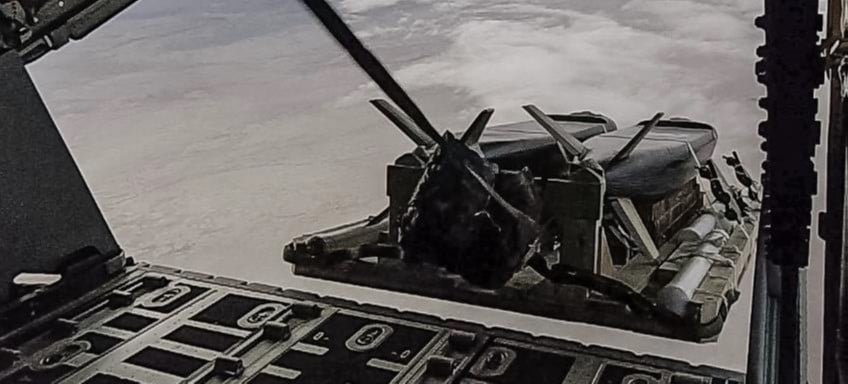
A CLEAVER 2-pack Pallet is deployed from MC-130J in an AFRL/AFSOC experiment.
UPDATED TO INCLUDE NEW DETAILS FROM AFRL.
WASHINGTON: The Air Force wants to equip cargo planes with semi-autonomous stand-off weapons for long-range fires for future all-domain operations, says Maj. Gen. Clint Hinote, deputy director of the Air Force Warfighting Integration Capability (AFWIC) office.
“It’s all about capacity, and you’ve got to create enough capacity so that long-range punch is really a punch,” he said in a Mitchell Institute briefing today. “And what we see is that, no matter how big our bomber force is, the capacity that the Joint Force needs is always more and more and more.”
Hinote argued that long-range air power is critical to the US military’s emerging concept for Joint All-Domain Operations (JADO) — part of a balanced solution that mixes so-called “inside forces” operating from within the theater and “outside forces” capable of stand-off targeting from very long ranges.
“You’re combining all of that together using your Joint All-Domain Command and Control effect, and you achieve what we call ‘convergence’ — that was a term that came from the Army and we agree with it,” he said. “And this idea of converging combat power from both the inside and the outside is the most important thing that the Joint Force commander has to get done.”
Hinote said that the Air Force has successfully tested the concept of “palletized munitions” on both the C-17 and the C-130, and is now exploring how to take it forward from the experimental phase.
“We are in discussions right now about how do we proceed to prototyping and fielding,” he added.
However, he noted that this would be a new initiative at a time when starting a new program is a tough sell due to a number of factors, including increasingly tight budgets.
“We’re in the last year of an administration, and we’ve had to turn in a budget early with not too many changes,” he said, “and where we are also looking at the possibility of a continuing resolution, where a new starts are going to be difficult to do.”
The Air Force Research Laboratory (AFRL) issued a Request for Information (RFI) on Feb. 27 to vendors who have existing capability for “roll-on, roll-off” munitions loading on cargo aircraft. “The concept of ‘a bomb bay in a box,’ where mobility aircraft air drop multiple, independent munitions from outside of a threat area could augment traditional delivery methods,” according to the RFI, which closed the window for submissions May 2.
UPDATE BEGINS. AFRL’s Strategic Development Planning and Experimentation (SPDE) office, which is managing the RFI, said in an email response to questions from Breaking D today that they have received five responses. UPDATE ENDS.
And today, AFRL issued a press release detailing a successful experiment, done in tandem with Air Force Special Operations Command (AFSOC), releasing “simulated palletized munitions” from an MC-130J on Jan. 28 at Dugway Proving Ground.
UPDATE BEGINS. Besides that set of experiments, the SPDE office also confirmed that they have conducted similar drops from the C-17 at Yuma Proving Ground in Arizona, in cooperation with Air Mobility Command and the 412 Test Wing.
“SDPE conducted five flight tests over Jan/Feb comprising airdrops from a MC-130J (with AFSOC) at Dugway and a C-17 at Yuma (with AMC and the 412TW). No cost figures are available,” SPDE said. UPDATE ENDS.
The MC-130J experiment was designed to explore the palletized munitions concept, which the release describes as “an innovative concept in which a multi-engine platform carrying large quantities of network-enabled, semi-autonomous weapons accompanies remotely piloted aircraft and fighter jets in combat missions,” according to the AFRL press release.
The Phase 1 experiment involved “munitions stacked upon wooden pallets, or Combat Expendable Platforms (CEPs), deployed via a roller system,” AFRL explained. Five of the CEPs were dropped, each carrying six simulated munitions. Four of those were designed to mimic what AFRL “Cargo Launch Expendable Air Vehicles with Extended Range (CLEAVERs)” — “long-range, high precision weapons destroy moving and non-moving targets.”
“This successful [demo] is evidence of our commitment to evolve innovative weapons concepts and enhance our partnership with AFSOC to meet the needs of the National Defense Strategy,” said Col. Garry Haase, the director of AFRL’s Munitions Directorate. “CLEAVER represents a different approach to launching large numbers of long-range weapons, which will bring a new dynamic to the high-end fight.”
According to AFRL, future demos will include “CLEAVER glider vehicles, powered vehicles, and full-up vehicles with optional Warhead and terminal guidance.”
Air Force picks Anduril, General Atomics for next round of CCA work
The two vendors emerged successful from an original pool of five and are expected to carry their drone designs through a prototyping phase that will build and test aircraft.


























